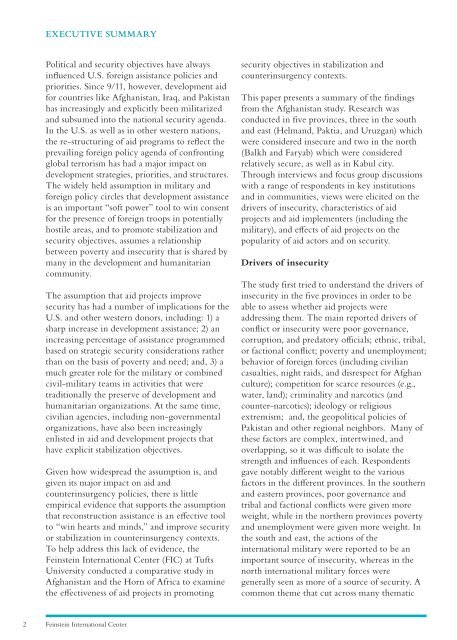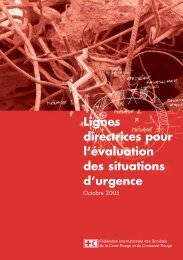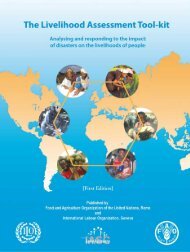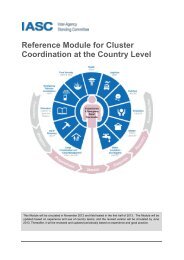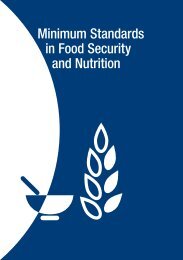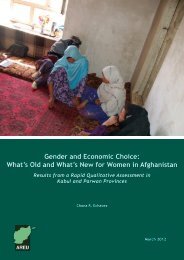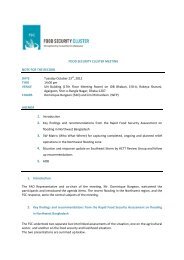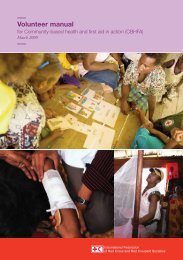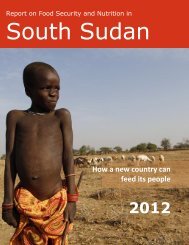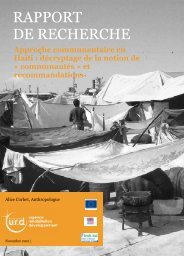Winning Hearts and Minds? - Tufts - Tufts University
Winning Hearts and Minds? - Tufts - Tufts University
Winning Hearts and Minds? - Tufts - Tufts University
You also want an ePaper? Increase the reach of your titles
YUMPU automatically turns print PDFs into web optimized ePapers that Google loves.
EXECUTIVE SUMMARYPolitical <strong>and</strong> security objectives have alwaysinfluenced U.S. foreign assistance policies <strong>and</strong>priorities. Since 9/11, however, development aidfor countries like Afghanistan, Iraq, <strong>and</strong> Pakistanhas increasingly <strong>and</strong> explicitly been militarized<strong>and</strong> subsumed into the national security agenda.In the U.S. as well as in other western nations,the re-structuring of aid programs to reflect theprevailing foreign policy agenda of confrontingglobal terrorism has had a major impact ondevelopment strategies, priorities, <strong>and</strong> structures.The widely held assumption in military <strong>and</strong>foreign policy circles that development assistanceis an important “soft power” tool to win consentfor the presence of foreign troops in potentiallyhostile areas, <strong>and</strong> to promote stabilization <strong>and</strong>security objectives, assumes a relationshipbetween poverty <strong>and</strong> insecurity that is shared bymany in the development <strong>and</strong> humanitariancommunity.The assumption that aid projects improvesecurity has had a number of implications for theU.S. <strong>and</strong> other western donors, including: 1) asharp increase in development assistance; 2) anincreasing percentage of assistance programmedbased on strategic security considerations ratherthan on the basis of poverty <strong>and</strong> need; <strong>and</strong>, 3) amuch greater role for the military or combinedcivil-military teams in activities that weretraditionally the preserve of development <strong>and</strong>humanitarian organizations. At the same time,civilian agencies, including non-governmentalorganizations, have also been increasinglyenlisted in aid <strong>and</strong> development projects thathave explicit stabilization objectives.Given how widespread the assumption is, <strong>and</strong>given its major impact on aid <strong>and</strong>counterinsurgency policies, there is littleempirical evidence that supports the assumptionthat reconstruction assistance is an effective toolto “win hearts <strong>and</strong> minds,” <strong>and</strong> improve securityor stabilization in counterinsurgency contexts.To help address this lack of evidence, theFeinstein International Center (FIC) at <strong>Tufts</strong><strong>University</strong> conducted a comparative study inAfghanistan <strong>and</strong> the Horn of Africa to examinethe effectiveness of aid projects in promotingsecurity objectives in stabilization <strong>and</strong>counterinsurgency contexts.This paper presents a summary of the findingsfrom the Afghanistan study. Research wasconducted in five provinces, three in the south<strong>and</strong> east (Helm<strong>and</strong>, Paktia, <strong>and</strong> Uruzgan) whichwere considered insecure <strong>and</strong> two in the north(Balkh <strong>and</strong> Faryab) which were consideredrelatively secure, as well as in Kabul city.Through interviews <strong>and</strong> focus group discussionswith a range of respondents in key institutions<strong>and</strong> in communities, views were elicited on thedrivers of insecurity, characteristics of aidprojects <strong>and</strong> aid implementers (including themilitary), <strong>and</strong> effects of aid projects on thepopularity of aid actors <strong>and</strong> on security.Drivers of insecurityThe study first tried to underst<strong>and</strong> the drivers ofinsecurity in the five provinces in order to beable to assess whether aid projects wereaddressing them. The main reported drivers ofconflict or insecurity were poor governance,corruption, <strong>and</strong> predatory officials; ethnic, tribal,or factional conflict; poverty <strong>and</strong> unemployment;behavior of foreign forces (including civiliancasualties, night raids, <strong>and</strong> disrespect for Afghanculture); competition for scarce resources (e.g.,water, l<strong>and</strong>); criminality <strong>and</strong> narcotics (<strong>and</strong>counter-narcotics); ideology or religiousextremism; <strong>and</strong>, the geopolitical policies ofPakistan <strong>and</strong> other regional neighbors. Many ofthese factors are complex, intertwined, <strong>and</strong>overlapping, so it was difficult to isolate thestrength <strong>and</strong> influences of each. Respondentsgave notably different weight to the variousfactors in the different provinces. In the southern<strong>and</strong> eastern provinces, poor governance <strong>and</strong>tribal <strong>and</strong> factional conflicts were given moreweight, while in the northern provinces poverty<strong>and</strong> unemployment were given more weight. Inthe south <strong>and</strong> east, the actions of theinternational military were reported to be animportant source of insecurity, whereas in thenorth international military forces weregenerally seen as more of a source of security. Acommon theme that cut across many thematic2Feinstein International Center


